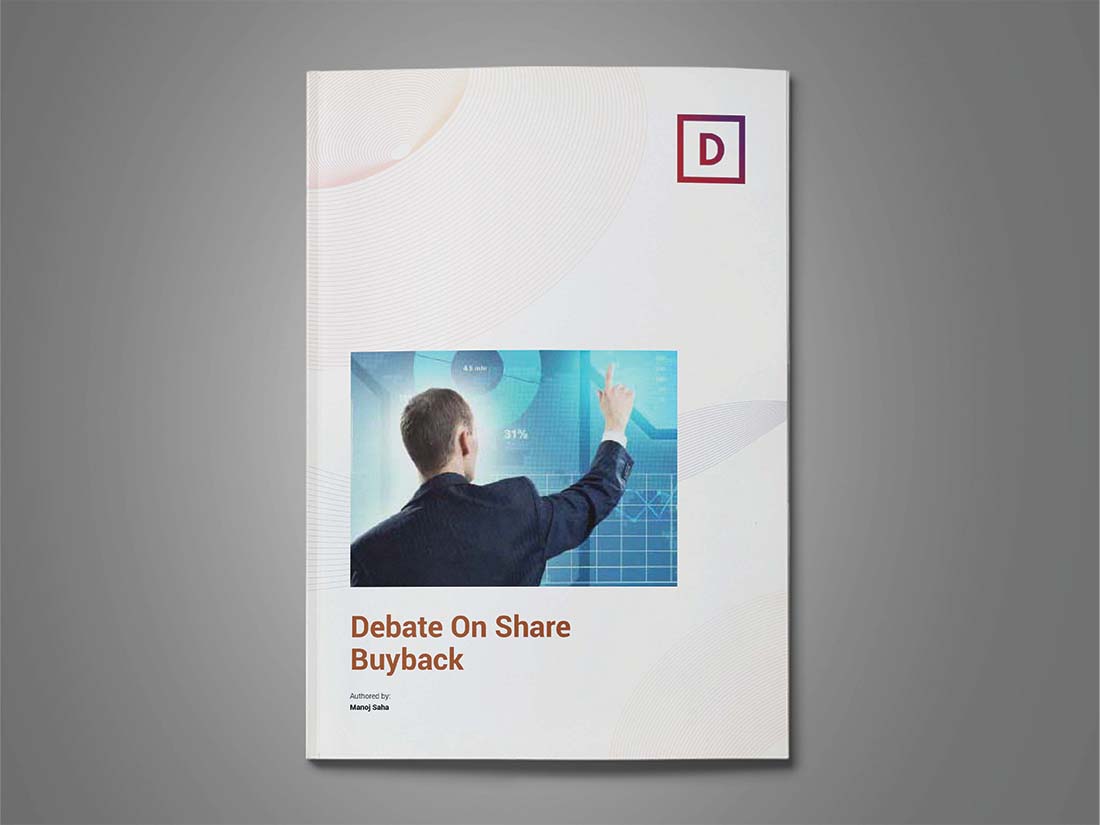DEBATE ON SHARE BUYBACK
Corporate share buyback is an effective tool to prevent companies’ share prices from devaluation and re-instilling promoter confidence. As the number of share buybacks climb, the debate over the concept heats up further.
In June 2013, the Securities & Exchange Board of India (SEBI), the Indian capital market regulator, did what was most desired by investors and shareholders. It raised the total buyback quantity to 50% of the company’s total buyback offer size, while simultaneously reducing the period of buyback to six months from the earlier period of one year. Moreover, it states that share buybacks upwards of 15% of the company’s total share capital will have to be made through a tender offer, besides also restricting companies from raising funds from the market for one year following the share buyback.
The step seems to have been taken at the right time. Revised guidelines regarding corporate share buybacks will ensure regulation in pricing, quantity and periodicity aspects of buyback offers. The revised guidelines will ensure companies make genuine share buyback offers and do not use them as a tool to prop up their stock prices.
In the past, companies have kept share buyback offers open for as long as a year, without actually buying a single share. Moreover, of the 75 buyback cases in the past three years, most companies touched less than 50% of their target for buyback.
In the backdrop of continued volatility in Indian stock markets, uncertain economic environment, sluggish business prospects, and weak consumer and investor sentiments, companies are increasingly resorting to share buyback as a tool to restore investor confidence in the company and its growth prospects.
WHAT ARE SHARE BUYBACKS?
Share buyback is one of the most important tools a company uses for its financial restructuring. It effectively re-engineers the company’s capital structure, reduces its capital employed and balance sheet, and at the same time, increases its earnings per share, dividend per share, return on equity and return on assets.
A corporate share buyback is usually attempted by a company when it has surplus cash after incorporating the future investment opportunities into its corporate strategy.
“Revised guidelines regarding corporate share buybacks will ensure regulation in pricing, quantity and periodicity aspects of buyback offers. The revised guidelines will ensure companies make genuine share buyback offers and do not use them as a tool to prop up their stock prices.”
Buyback of shares at a premium to their current market price sends out a strong signal to shareholders on the stock price’s undervaluation and displays the management’s conviction in the company. Companies often prefer to utilise corporate cash for share buybacks versus paying dividends or investing the piles of cash in the business.
As the move results in an increase in promoter’s stake, it reinforces their promoter’s confidence in the company’s fundamentals and future potential.
Investors usually favour share buybacks on two conditions are met. First, when a company has ample funds to take care of the operational and liquidity needs of its business; and second, when the stock is selling at a material discount to the company’s intrinsic business value, conservatively calculated.
NEW GUIDELINES ON CORPORATE SHARE BUYBACK AND SEBI’s RATIONALE FOR REVISON
| Mandate | Old Guideline | New Guideline | Rationale for Revision | Impact of Revision |
|---|---|---|---|---|
| Minimum Buyback Quality | 25% of the offer size | 50% of the offer size | Between 2008 and 2011, nearly 75 share buyback offers were announced where only 49.1% of buyback target was achieved, suggesting that buyback offer was not used optimally to enhance book value. | In the event 50% buyback is not ___, the company will have to forfelt 2.5% of total amount earmarked or share buyback. |
| Maximum Buyback Period | 12 months | 6 months | Companies tend to keep share buyback offers open for entire 12 months and buy shares at their own discretion, instead of buying at regular intervals. There are instances where companies haven’t bought a single share. On the flip side, companies which are serious about share buyback programs have been able to buy back a significant portion (~49%) within first 3 months. | Companies are mandated to put in 25% of the maximum amount proposed for share buyback in an escrow account for a period of 6 months. |
| Post Buyback Obligations | No further capital raising for 6 months | No further capital raising for 1 year | In case of share buyback being financed through cash resources, the company tends to utilise idle cash resources with no attractive investment opportunities in the foreseeable future. Hence, it shouldn’t have any immediate capital requirement. | There will be no capital raising activity or another share buyback offer for a period of one year from the date of closure if the ongoing buyback offer. Further, promoters will also be barred from executing any transaction on-market or off-market during the share buyback period. |
| Buyback of >= 15% of Capital | Tender Offer or Open Market Offer | Only Tender Offer | In an open market offer, shares are bought back by the company at the prevailing market price. In the tender offer method, the shares are bought back at a fixed price, usually at a premium to the market price. So, the tender offer method is a more equitable way of distributing surplus funds to the shareholders. | In an open market offer, the company can buy its shares from the market without knowing the buyer. While in the tender offer, the company has to write to its shareholders individually to understand their willingness for sale of shares through the buyback route. |
“When a company buys back shares by reinvesting their own capital into the company, it reinforces their confidence in the company’s business, thus helping prop up the share price. In the event of the number of outstanding shares decreasing due to a share buyback, the shareholder value or Earnings Per Share of the stock increases. Companies often continue to protect their earnings by buying back the number of shares necessary to prevent earnings dilution.”
Let us take a look at the benefits a share buyback can have.
| a. | Sizeable Cash: Companies sitting on piles of cash are often under pressure to return the value to the shareholders. Share buybacks send out a positive signal to investors. When a company announcing share buyback has sizeable cash reserves, it is utilised to buyback shares at a premium to the market price, giving a strong indication to markets that the stock is undervalued. Share buybacks also help in reducing the number of outstanding shares and in improving the Earnings Per Share, return ratios, and the balance sheet. |
| b. | Rising Share Prices: When a company buys back shares by reinvesting their own capital into the company, it reinforces their confidence in the company’s business, thus helping to prop up the share price. Citing a recent example, the stock of FMCG player Hindustan Unilever Ltd was quoting at ` 583.80 on April 30, 2013, the day of its share buyback announcement. The company announced its intention to buy shares from the market at ` 600 a share, a premium to the then quoting share price. A month after the buyback announcement, the share price surged to ` 595.60 a share. |
| c. | Increased Shareholder Value: One way to measure the companies making prudent share buybacks is to compare the valuations at which they pay for their own shares to the stock’s historical median valuation. In the event of the number of outstanding shares decreasing due to a share buyback, the shareholder value or Earnings Per Share of the stock increases. Companies often continue to protect their earnings by buying back the number of shares necessary to prevent earnings dilution. |
| d. | Increased Float: As the outstanding share count of the company decreases, the remaining shares represent a larger percentage of the float. If demand for the stock increases and there is less supply of stock, it leads to an upward movement in the price of the stock. Fewer outstanding shares means the remaining shares are worth more. The value of the stock changes as there are now fewer shares outstanding. |
| Project Status | DOB* | Maximum Buyback Amount (₹ Cr) | Maximum Buyback Price(₹ Cr) | Price On DOB | Price 1M before DOB | Price 3M before DOB | Price 1M after DOB | Price 3M after DOB |
|---|---|---|---|---|---|---|---|---|
| Infinite Computer Solutions | 19 Jun 2013 | 30 | 120 | 83.9 | 86.5 | 106 | – | – |
| S Mobility | 19 Jun 2013 | 60 | 75 | 35.4 | 38.2 | 26 | – | – |
| HT Media | 14 May 2013 | 25 | 110 | 99.2 | 95.6 | 102.1 | 99.7 | – |
| Aptech | 13 May 2013 | 64.7 | 82 | 58.5 | 45.6 | 50.95 | 59.55 | – |
| HUL | 30 Apr 2013 | 25,000 | 600 | 583.8 | 466.9 | 477.5 | 595.6 | – |
| GSK Consumer Healthcare | 26 Nov 2012 | 5,222 | 3,900 | 3,659.2 | 3,094.4 | 2,909 | 3,826.6 | 3,887 |
| Kirloskar Oil Engines | 25 Jan 2012 | 76.3 | 170 | 141.5 | 115.6 | 125.3 | 139.6 | 153.9 |
| Reliance Industries | 20 jan 2012 | 10,440 | 870 | 792.7 | 713.5 | 838.7 | 843.6 | 730.9 |
| *DOB – Date of Buyback Announcement |

DEBATE ON SHARE BUYBACK
To download and save this article.
Authored by:
Manoj Saha
manoj.saha@dickensonworld.com
To know more on how Dickenson can assist you at this critical juncture, email to enquiry@dickensonworld.com


Leave A Comment